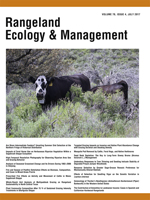Bison (Bison bison) were historically distributed throughout North America with the northern edge of the distribution occurring in north-central Manitoba and surrounding provinces. Despite bison occupying the boreal zone of North America, little is known of their forage selection patterns of herbaceous plant material when occupying pastures within a densely forested aspen ecosystem. In 2015 we initiated a study to examine forage selection patterns for bison among and within summer months (June–August). We hypothesized that vegetative composition of bison diets would be consistent with availability, would shift with forage availability, and would predominately consist of grass and sedge species. We opportunistically collected adult female bison fecal samples (N = 99) and identified forage composition using the DNA barcoding method. We estimated availability of forage to the lowest taxonomical level possible using a modified Daubenmire frame. Overall, bison diets were composed of 44.3% grass, 37.7% forb, 16.3% browse, and < 2% sedge and rush. Forage availability comprised 51.2% grass, 28.3% forb, 11.0% sedge, and 7.6% rush. All analyses indicated that use and availability for grass, forb, sedge, and rush differed (P ≤ 0.05) throughout the summer. Grass and forbs were important dietary components for bison, comprising > 80% of bison diets. However, bison selected for these two dietary components independently as the summer progressed. Our results indicate that these bison consume a large portion (∼54.0%) of low-cellulose, high cell-soluble forages to meet their dietary needs. This suggests that bison may be or become intermediate foragers and are more like elk (Cervus elapus) than domestic cattle or sheep when inhabiting forested systems at the northern edge of their historical distribution. Herd managers and biologists should be cognizant of the importance of eudicots for bison and adopt a management plan that promotes a spatially heterogenous vegetative schematic.
How to translate text using browser tools
1 July 2017
Are Bison Intermediate Feeders? Unveiling Summer Diet Selection at the Northern Fringe of Historical Distribution
Joshua L. Leonard,
Lora B. Perkins,
Duane J. Lammers,
Jonathan A. Jenks
ACCESS THE FULL ARTICLE

Rangeland Ecology and Management
Vol. 70 • No. 4
July 2017
Vol. 70 • No. 4
July 2017
bison
diet selection
DNA barcoding
grass-roughage-intermediate feeders
Manitoba
next-generation sequencing




